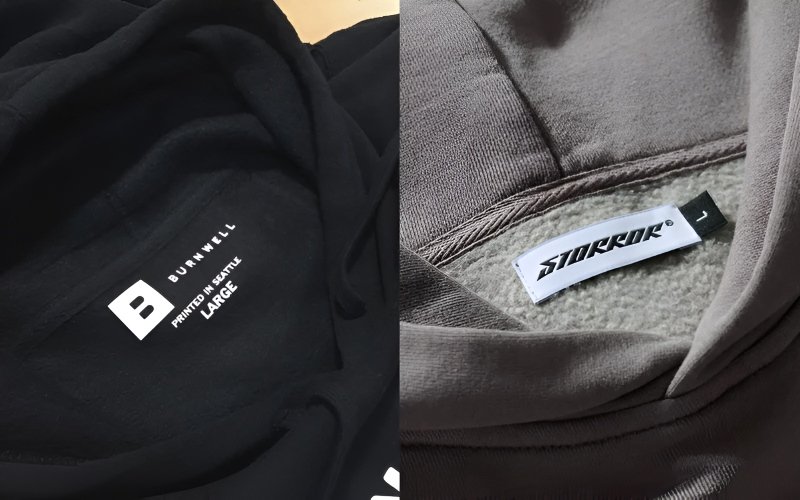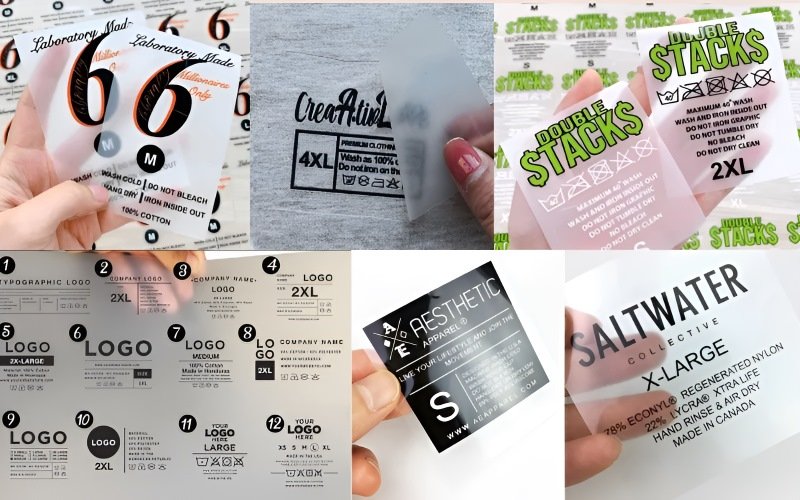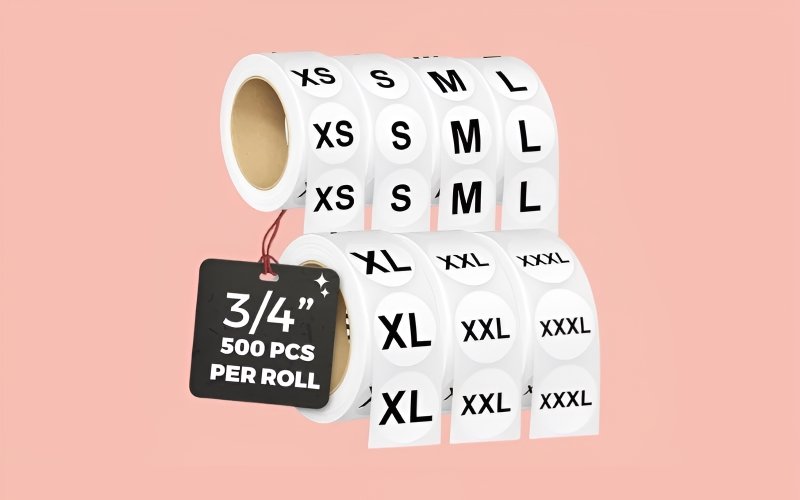Size label materials for clothing: Choosing the right choice
Are you a small to medium-sized clothing brand, navigating the complexities of material selection for your size labels? Feeling overwhelmed by choices, concerned about durability, and balancing cost-effectiveness with your brand image, while ensuring regulatory compliance? In today’s competitive market, accurate and durable size labels are crucial for online sales and wholesale success. This article will provide expert guidance on selecting the right label materials, ensuring your labels are durable, compliant, and enhance your brand.
1. Importance of choosing the right size label materials
Size labels are far more than simple indicators; they are a crucial touchpoint for brand communication and the overall customer experience. They can be a significant factor in customer satisfaction. Clear, durable size labels help prevent confusion and ensure customers receive the correct fit, thus minimizing returns and increasing customer satisfaction.
The material and appearance of these labels reflect your brand values. The right choice will help reinforce brand professionalism and quality perception. Cheap, flimsy labels detract from the quality of a garment. Choosing the right material ensures legal and regulatory compliance for garment sizing and fiber content, therefore building trust and avoiding potential legal issues.
2. Understanding different size label material types: A brand’s guide
Woven size labels are a time-honored choice, offering a sophisticated and durable option, created by weaving threads together. Common materials include polyester, cotton, satin, and damask. Polyester is an excellent choice for durability, while satin offers a luxurious softness.
They are highly durable, offering a luxurious feel, perfect for branding and are easily washable for a long-lasting design. Cons include a higher cost and longer lead times. They are best for high-end clothing and brands emphasizing quality and heritage.

2.2 Printed size labels: Versatile and cost-effective
Printed size labels are versatile and cost-effective, created by printing directly onto various materials. Materials like satin, taffeta, and Tyvek are common. Satin offers a luxurious softness, while Tyvek is known for its tear-resistance.
They offer flexibility in design and cost-effectiveness. The pros include faster production, a wide range of material and color options, and suitability for detailed designs, whereas the cons can include being less durable than woven labels, depending on the material and printing method, and can fade or crack over time with harsh washing. They work best for everyday clothing, fast-fashion brands, and for children’s wear.

2.3 Heat transfer size labels: Comfort and direct application
Heat transfer labels are created by printing ink onto a carrier film and then applying the design directly onto the garment fabric using heat. It’s a tagless option, offering maximum comfort. Materials commonly used include heat transfer vinyl (PU, PVC) and specialized heat transfer papers.
The pros include tagless comfort and direct application. Cons include that durability depends on the application and heat transfer vinyl quality, and the design can crack or peel if not applied correctly and the design is limited. They are best for baby and children’s clothing, sportswear, and brands focusing on comfort.
Expert Tip: proper application is key for heat transfer labels. Always test on a sample garment first to ensure wash durability.

2.4 Adhesive size labels: Temporary and practical
Adhesive size labels have a sticky backing for easy application. Primarily used for temporary purposes. Materials include paper, vinyl, and polyester, with a variety of adhesive backings. They are easy and quick to apply, needing no sewing or heat pressing.
They work well for temporary labeling and are versatile for various surfaces. However, they are not as durable as sewn or heat-applied labels. They can weaken over time or with washing, and may leave residue. They are best for retail price tags or for inventory management. Note: While less common for permanent size labels on garments, adhesive labels are helpful in production or for specific retail scenarios.

3. Key factors to consider when choosing size label materials for your brand
3.1 Durability and garment type
The garment’s intended use and washing frequency are important factors. High-wash items such as kids’ clothes and sportswear need durable labels. If the items will be in a harsh environment such as outdoor wear, choose materials resistant to abrasion, chemicals, and weather. Delicate garments, like lingerie, will require softer, less intrusive label materials.

3.2 Brand aesthetics and material feel
Does the material align with your brand’s image? Luxury brands often prefer woven satin, while eco-conscious brands may use recycled materials. Consider the tactile feel of the label against the skin. Softness is crucial for comfort. Also, consider the visual appearance of the label.

3.3 Cost and budget
Balance material quality with budget constraints. Woven labels are considered premium but are pricier. Printed labels offer more cost-effective options. It’s also important to consider bulk discounts and minimum order quantities from suppliers. In the long run, investing in durable labels can reduce customer complaints and returns.
3.4 Regulatory compliance and information needs
Ensure labels comply with relevant regulations. Material choice can impact the printability of required information. Consider the space needed for the size, care instructions, and brand logo. The durability of the printed information must be considered to prevent fading.
4. Label finishes: Enhancing appearance and functionality
Various finishes can enhance the appearance and functionality of your labels. You can select from gloss, matte, satin, semi-gloss, reflective, and even glow-in-the-dark finishes. These finishes impact label readability under different lighting conditions. Matte finishes reduce glare, and gloss finishes can make the design more vibrant. Some finishes offer scratch resistance, which can improve the durability of your label.

5. FAQs about size label materials
5.1 What are the most durable size label materials for children’s clothing?
Woven polyester or printed Tyvek/taffeta, due to their washability and tear-resistance, and heat transfer labels, if applied correctly.
5.2 How can I get cost-effective size labels without sacrificing quality?
Printed satin or taffeta labels are a good balance. Consider bulk ordering and simpler designs. Heat transfer is a good option for smaller runs.
5.3 What are the best size label materials for sensitive skin or baby clothes?
Soft printed satin or 100% cotton woven labels are often best. Tagless heat transfer labels are also ideal to avoid irritation.
5.4 Are there eco-friendly or sustainable size label material options?
Yes. Recycled polyester woven labels, organic cotton labels, and some biodegradable printed label materials are available.
5.5 How do I ensure my size labels comply with clothing labeling regulations?
Research the specific regulations for your target market. Select materials that allow for clear printing of all required information, such as fiber content, country of origin, and care instructions. Consult with a label supplier familiar with the regulations.
6. Packlove – Your partner for high-quality clothing size labels
Packlove has over eight years of experience in the garment industry, specializing in processing clothing labels and tags. We can advise you and provide exactly what you need. We provide a wide range of size label materials and printing options, including woven labels, printed labels, heat transfer labels, and adhesive labels. We are committed to quality and durability. We can assist with custom design, material consultation, and have fast turnaround times.
Visit our website at https://mypacklove.com/ or contact us at [email protected] to explore our options and contact us for a free consultation.
Read more:
Choosing the right size label materials is crucial for brand success. Carefully consider durability, aesthetics, cost, and regulatory compliance. It’s important to evaluate your specific needs and explore different options. Let Packlove help you find the perfect size label materials to elevate your brand. Visit MyPackLove.com to learn more.






















